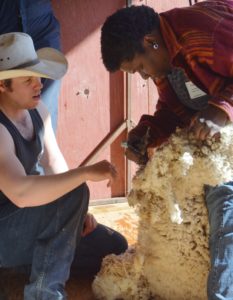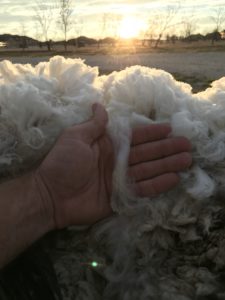Sheep shearing, wool and mohair schools set for Jan.
12-14 in San Angelo
By: Blair Fannin
SAN ANGELO – The Texas A&M AgriLife Extension Service will host multiple
comprehensive wool education schools at the Texas A&M AgriLife Research and
Extension Center, north of San Angelo on U.S. Highway 87.
(Texas A&M AgriLife Extension Service photo)
The Texas A&M AgriLife Extension Service will host
multiple comprehensive wool education schools at the Texas A&M AgriLife
Research and Extension Center, north of San Angelo on U.S. Highway 87. The
Texas A&M AgriLife Shearing School and the Wool and Mohair Schools are
scheduled for Jan. 12-14.
(Texas A&M AgriLife Extension Service photo)
The Texas A&M AgriLife Shearing School and the Wool and Mohair Schools are scheduled for Jan. 12-14.
The shearing school continues to grow in popularity, said Dr. Reid Redden, AgriLife Extension state sheep and goat specialist at San Angelo.
“Students appreciate the hands-on instruction, and the popularity of this school has made participant slots limited, so we are encouraging those interested to apply as soon as possible,” Redden said.
The school is meant to train the next generation of shearers by offering the most innovative technology available to harvest wool, he said. Shearing is physically demanding and participants should be aware that the skills taught require hard, manual labor.
“They should arrive willing to work and dressed in proper working attire,” he said.
Redden noted that whether individuals are new to shearing or wanting to hone their technique, something will be offered to everyone.
“The school has instructors who teach both international shearing pattern, often called Australian style, and the more commonly used shearing style in Texas. In addition to sheep, we also teach students to shear Angora goats, which makes our school unique to most other schools in the nation.”
Redden said the goal for all these schools is to develop industry professionals willing to use the most efficient technique, equipment and tools to harvest wool for sheep ranches of any size.
The wool-classing school is a separate school that teaches participants to sort wool into separate categories to improve the value of the wool clip for the grower and buyer, he said.
Dr. Ronald Pope, Texas A&M AgriLife Research director of the Bill Sims Wool and Mohair Research Lab, will coordinate the training.
“Both curriculums will complement each other,” Redden said. “And perhaps most importantly, students engage with industry professionals from ranch gate to retail shelf, which provides the opportunity for lifelong learning.”
The class sizes are limited due to the hands-on instruction, so applications for both schools must be submitted by Dec. 1. Successful applicants will be notified by Dec. 7.
Registration for the shearing school is available at https://agrilife.org/sheepandgoat/registration/. Registration for the mohair school is available at https://agrilife.org/sheepandgoat/woolmohair/. Those interested in registering may also phone 325-653-4576.
Individual registration for the shearing school or wool classing school is $150 for Texas residents and $250 for non-residents. Students will receive a sheep shearing handbook and DVD or wool classing manual. Previous students will receive a $100 discount.
The minimum age for participating in either course is 16 years old.
The school is a collaborative effort among AgriLife Extension, AgriLife Research, the American Sheep Industry Association and the Texas Sheep and Goat Raisers Association.
-30-
We grant permission for the use of this news as a free service to the news media. Articles may be used either in their entirety or in part, provided that attribution remains. You may use the stories and art, or you may put the stories, art and/or news videos on your websites. High resolution photos, audio and video also are provided with many of our articles for your use at agrilife.org/today



No comments:
Post a Comment